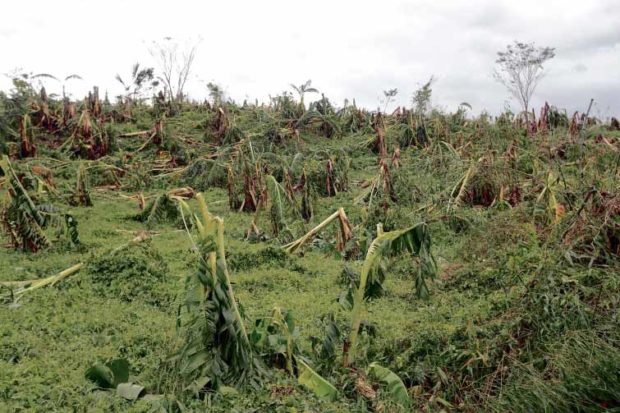‘Rosita’ downs power lines in 4 provinces

DEVASTATED PLANTATION Banana plants in San Agustin, Isabela province, were blown down by winds brought by Typhoon “Rosita.” Banana is the town’smain agricultural product. GRIG C. MONTEGRANDE
Residents of Northern Luzon, who had expected a monster storm, heaved a sigh of relief on Tuesday when only moderate rains fell on Benguet, Mountain Province, Pangasinan, La Union and Ilocos Sur, which had all been placed under Storm Signal No. 3.
One fatality was recorded in Tarlac province and a fisherman was reported missing in waters off Quezon province.
Typhoon “Rosita” (international name: Yutu) made landfall in Dinapigue town, Isabela province, at around 4 a.m., packing sustained winds of 140 kilometers per hour and gusts of 240 kph that knocked down trees and power posts, and ripped roofs off small houses.
Downed power lines caused blackouts in the provinces of Cagayan, Isabela, Quirino and Nueva Vizcaya, according to the Office of the Civil Defense (OCD) in Cagayan Valley.
After crossing over the Sierra Madre mountain range, the typhoon hammered the towns of San Guillermo, Jones, Echague, San Agustin and Santiago City — all in Isabela — before blowing through Quirino, Nueva Vizcaya and Benguet.
Fatality
In San Clemente town, Tarlac, James Bautista, 25, was pushing the motorcycle of Elpidio Parana, 42, when they were electrocuted by power lines toppled by the typhoon at Barangay Bamban.
Bautista died before reaching the hospital, while Parana, a council member of Barangay Cacaoiten in Mangatarem town, Pangasinan province, suffered burns.
A fishing boat carrying three fishermen capsized on Monday morning in waters off Quezon.
Two fishermen were rescued, but a third remains missing.
Waves destroy homes
More than 100 houses, mostly made of light materials, were destroyed by strong waves at several coastal villages in three towns of Northern Samar province on Monday morning.
The water levels at the coastal villages in the towns of Pambujan, Mapanas and Catarman rose up to 3 meters between 8 a.m. and 9 a.m., said Rei Josiah Echano, chief of the Provincial Disaster Risk Reduction and Management Office.
All three towns are facing the Pacific Ocean.
In Jones, Isabela, two hours after Rosita pounded southern Isabela with 140 kph winds at about 7 a.m. on Tuesday, 68-year-old Jessie Domingo, his son Jaybie, 42, and grandson Junar were fishing from the banks of the raging Cagayan River at Barangay Palagao.
Just an ordinary typhoon
The town was among those that took a direct hit from Rosita, but for residents it was just another ordinary typhoon.
On Tuesday morning, the Domingos were among groups of local fishermen who were driven away from the riverbank at Palagao by local policemen, warning them of the risk as winds were still pounding and the river beginning to swell.
“The winds were just too strong. I kept praying everybody will get through this alive,” said Jones Mayor Letty Sebastian, as she supervised the deployment of rescue teams on Tuesday morning.
In San Agustin town, the plantations of banana, the town’s main agricultural product, turned into landscapes of twisted stumps.
Residents expressed relief the typhoon caused relatively little damage to crops and structures.
Natural barrier
They credited the weakening effect of the Sierra Madre range, which had always served as the province’s natural barrier against howlers from the Pacific Ocean, on typhoons.
“Not only does [the Sierra Madre] disrupt the wind circulation; it also deflects strong winds to an upward direction, away from houses,” said farmer Ernesto Rimando, 59.
Rains brought by Rosita caused rivers in Isabela to swell, engulfing a number of bridges, including Masaya Sur (in San Agustin town), Gucab and Annafunan (Echague), Cabisera 5 and 8 (Ilagan City), Cansan (Cabagan), and Santa Maria-Cabagan (Santa Maria).
In Cagayan, Abusag bridge in Baggao town and Tawi bridge in Peñablanca town were not passable either, according to a report from the OCD in the region.
Also not passable were San Pedro bridge in Maddela town, Quirino province, and Runruno bridge in Quezon town, Nueva Vizcaya, said OCD operations officer Bryan De Vera.
Minor complaints
In Baguio City, disaster response teams dealt with minor complaints like clogged drains.
Nothing untoward was reported in Benguet province, where more than 90 people died due to landslides that buried portions of the mining town of Itogon when Typhoon “Ompong” (international name: Mangkhut) struck on Sept. 15.
Nearly 10,000 people fled their homes ahead of Rosita’s arrival.
Rosita is expected to exit the Philippine area of responsibility on Wednesday, though the weather bureau has warned of continued rains in the western section of Luzon.
The typhoon exited the Luzon landmass in La Union province at 2 p.m. on Tuesday.
The typhoon is still expected to bring light-to-moderate rains on Wednesday to the western section of northern and central Luzon, some parts of southern Luzon, and even Metro Manila. —With reports from Jeannette I. Andrade, Gabriel Cardinoza, Maria Adelaida Calayag, Valerie Damian, Armand Galang and Joey A. Gabieta